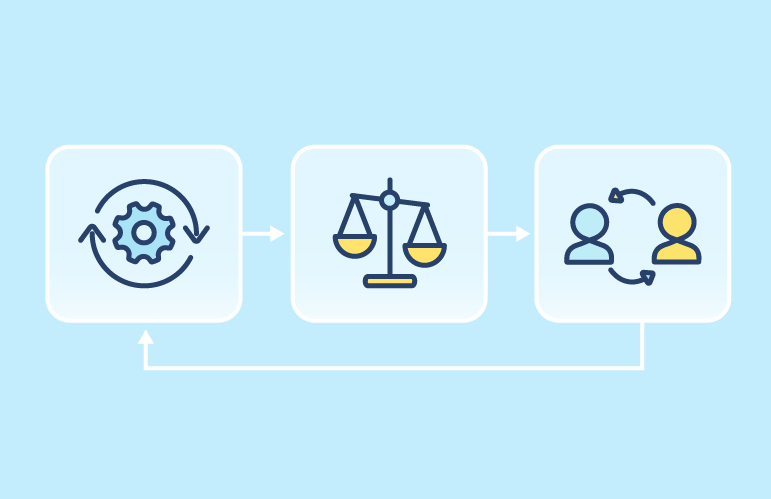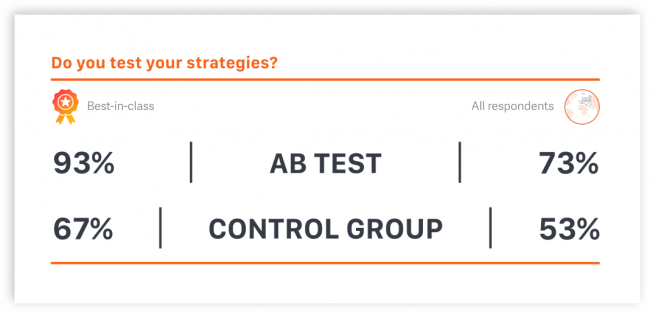Three Keys to CRM Success, Part 2: Testing Strategy


Catégorie : Stratégie CRM
Welcome back to part 2 of our 3-part series: Keys to CRM Success: Testing Strategy.
For those of you just joining, this series is a follow-up to our State of CRM report generated from a survey in which 100 CRM professionals from around the world answered questions about their CRM team, strategy, challenges, and goals for 2021.
In part 2 of the series, we are going to explore how successful CRM teams are measuring success and seizing opportunities based on analytical insights.
And the motto for this post is… Execute, measure, socialize, repeat!
In my previous professional life, I was the owner/operator of a boutique fitness studio. We were a small business with a few locations. My role there included everything from handywoman to marketing to teaching indoor cycling classes – classic small biz set up.
I attended a business seminar during our second year in business and had a rude awakening.
Two questions stopped me in my tracks:
First of all, let me just say, ignorance was bliss in this situation. Not knowing the answers to these questions allowed us to live in the illusion we were experiencing great success and had no worries retaining customers.
Let’s just say we had room for improvement…
We all know that failure is an opportunity.
I quickly realized I had no idea how to measure my retention rates accurately, nor did I have a clue as to what strategy was having the most impact. This means I was not able to prioritize my team’s tasks, time or challenges effectively.
The first thing I did was to define a method to measure retention and measure impact from each retention strategy I had in place.
Next, we began to review and test our approaches.
Were our tests perfect? No.
But we never gave up on retention and our experimentation and constant measuring helped us to stay well below the industry average churn rate, much improved from where we started.
Cue the motto: execute, measure, socialize, repeat.
Now, I say without a doubt, from my own experience, testing and measuring is a key to success.
I know I am in good company saying this too.
Maybe you’ve noticed more and more companies have departments dedicated to experimentation now? Really exciting!
In the State of CRM 2021 report, when we asked CRM professionals if they test their CRM strategies 73% said they are conducting AB tests.

They almost seem too basic to include, but really AB testing is critical to success in CRM and successful teams are 100% dedicated to the test and learn philosophy.
Whether you are testing copy, content, creative, send times, layouts, or targeting, AB tests are relatively easy and inexpensive tests to run.
It’s as easy as comparing option A to option B.
However, remember our motto.
Tests shouldn’t be done once and never revisited. Revisiting hypotheses and assumptions with repeated testing over time is the key to learning what is working and what isn’t.
In practice, control groups are quite simple: a certain population of your customer base is withheld from receiving the strategy you intend to test over a period of time.
This allows you to measure the effectiveness of your testing strategy and to make informed decisions about whether you should make adjustments.
However, depending on the size of your control group, statistically significant results can take time to appear, so patience is key.
More on control groups can be found here.
Additionally, not all CRM teams are equipped with the functionality to put proper control groups in place – they should be random and consistent over a period of time.
We see advanced teams using control group measurements to inform larger, more sweeping changes they are considering making as they can take time to see conclusive results.
Ok, so you’ve executed tests on your strategy and measured impact. Now what?
Socialize! You need to share your learnings with your peers and leadership.
It is really important to socialize and spread learnings from tests and to show the impact you’ve measured.
If we learned anything from the state of CRM Report, it’s that CRM teams work with and rely on many different departments in organizations.
Remember, CRM teams have direct contact with the customer, other teams don’t.
Keep your partners informed of your learnings so they can support the CRM strategy to the best of their ability, and work on being and staying “customer-centric” with the CRM team.
Finally, because repetition works….
Execute, measure, socialize, REPEAT.
That’s when you should enter into a cycle of iterations and make sure that you implement the learnings from your tests, and repeat, over and over again.
Stay tuned for the final piece in our 3-part “Keys to CRM Success” series, where we’ll address how to find the right tools for your CRM needs.